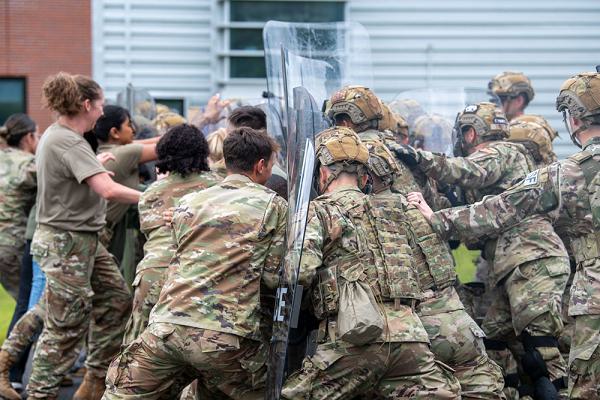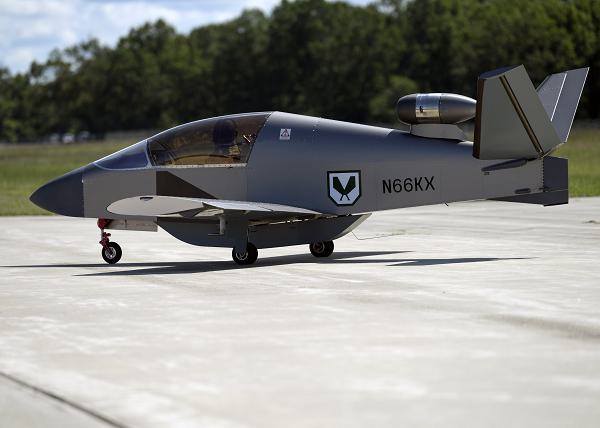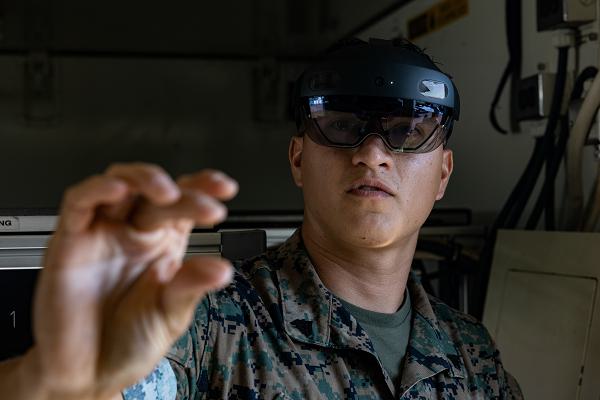- Details
- Hits: 1895

Westfield, Massachusetts. (August 31, 2024): In America, everyone has the right to demonstrate, march, and protest and such activities are protected under the First Amendment to the U.S. Constitution. In this photo by Jay Hewitt, members of the 104th Fighter Wing Security Forces Squadron conduct riot control training with civilians volunteering to function as an unruly crowd. The event offered riot control teams invaluable training in crowd control and tactical strategies.
While legitimate protests are an essential right, there are times when these types of gatherings get out of control and law enforcement is forced to step in. Websters describes a civil disturbance as “an unlawful assembly that constitutes a breach of the peace or an assembly of individuals that creates a threat of property damage, violence, or other unlawful acts.” Responding to these disturbances requires understanding proper crowd control tactics that protect life and property without unduly restricting a citizen’s right to protest.
When training for riot control, there are some essential skills and techniques that security officers should learn. The first task is to have a concise plan in place on how to deal with crowd control before things get out of hand. Officers should have clearly defined roles in managing unrest and they need to understand under what circumstances they can use force or make arrests.
- Details
- Hits: 1670

Alpena Combat Readiness Training Center, Michigan. (September 2, 2024): The devastating impact of unmanned aerial vehicles (UAVs) on the battlefields of Ukraine has prompted the Air Force to embrace the Kestrel JSX-2 microjet, a small, agile aircraft to simulate against such threats. In this photo by Technical Sergeant Tristan D. Viglianco, a JSX-2 microjet participates in Exercise Northern Strike 2024-2, the Air National Guard’s premier reserve component training event. More than 6,300 personnel from thirty-two states as well as “several international participants” joined in the action, hosted at the National All-Domain Warfighting Center.
The Air Force is using this light aircraft primarily for training purposes, particularly in simulating enemy unmanned aerial systems during large-scale military exercises like Northern Strike. The microjet’s small size, speed, and maneuverability make it an effective tool for replicating the behavior of UAVs and cruise missiles like those being launched over the skies of Ukraine.
These tiny, homebuilt microjets, developed by SubSonex Aircraft, are extremely light with an empty weight of just five hundred pounds and a length of sixteen’ 6” feet with a wingspan of eighteen feet. The jet has a maximum speed of 287 miles per hour and is valued at $725,000. The aircraft is used as a platform for pilots to train in various skills including detection, identification, and destruction of UAVs in a live-fly environment.
- Details
- Hits: 904

Newport News, Virginia. (September 1, 2024): The Navy has opened a first of its kind outdoor fitness pavilion here to serve the athletic needs of Sailors living at the Huntington Hall Naval Berthing Facility. In this photo by Max Lonzanida, a Sailor prepares to perform squats at the facility which opened this week. The eight hundred square foot structure of dedicated fitness space is modular, hurricane resistant, and utilizes solar lighting to remain open to Sailors to utilize 24/7. The pavilion can accommodate up to 120 Sailors at any given time and offers a variety of free weights, kettle balls, jump ropes, workout balls, pull up bars, climbing ropes, squat racks, and other fitness equipment. The facility was the brainchild of the leaders of Naval Weapons Station Yorktown and the staff from the Morale, Welfare and Recreation department.
The facility is designed for warfighters that work on ships with irregular schedules who need a good work out day or night. It took about eight-months and over $325,000 to create the open-air gym that offers a variety of cross-fit and high intensity interval exercises. There are spaces for pull ups, several climbing ropes, bench press, axle attachment points for barbel weights, and several squat rack stations. The gym has also become popular for group sports sessions such as basketball tournaments and dodgeball events, among others.
The Navy is planning to open facilities like these at all major land-based ports in the U.S. to enhance the quality of life of Sailors and their families.
- Details
- Hits: 1082

Oklahoma City, Oklahoma. (August 31, 2024): The All-Navy Women's team dominated the competition in a series of softball tournaments this week winning bragging rights as the best team in 2024. In this photo by the DOD’s EJ Hersom, Marine Corps Staff Sergeant Bailey Stiwinter swings at the ball during the home run derby competition at the 2024 Armed Forces Men’s and Women’s Softball Championship.
The event featured top athletes from the Army, Navy, Air Force and Marine Corps battling it out at Oklahoma City’s Devon Park. The competition involved a three-day double round robin series followed by an additional two-day elimination championship to determine which team would claim the crown.
The event is sponsored by U.S. Armed Forces Sports, an affiliate member of USA Softball, which has held softball competitions dating back to 1972. Teams are comprised of active duty, reserve, and national guard personnel from military installations across the world. This year, both the All-Navy Women’s team and All-Army Men’s team were defending their 2023 titles.
After coming into the double elimination championship series as the third seed, the Navy All-Women’s team got off to a shaky start with a 6-8 loss to the Air Force in the first round before rallying to beat the Marine Corps 11-10.
- Details
- Hits: 1095

Joint Base Lewis-McChord, Washington. (August 30, 2024): Most Americans do not realize the critical role our Soldiers play in fighting the rash of wildfires across our nation. In this photo by Christopher Grissett, Soldiers from the 14th Brigade Engineer Battalion, 2-2 Stryker Brigade Combat Team, 7th Infantry Division deploy as part of the Department of Defense wildland firefighting response.
For years, the Army Northern Command’s Joint Force Land Component Command has dispatched active-duty Soldiers to help battle the flames when requested by the National Interagency Fire Center and approved by the Office of the Secretary of Defense. The Command rapidly deploys military ground personnel to support civil authorities to protect people, property, and land. This assistance includes a Modular Airborne Fire Fighting System equipped with aircraft, military helicopters, and ground forces capable of supporting firefighting efforts.
The Department of Defense (DOD) manages nearly twenty-seven million acres of public lands that are home to over five hundred threatened or endangered species as well as native plants and animals that can only be found in certain geographical areas. A key part of land management is conducting prescribed fires and mechanical fuel reduction to lessen the severity of these blazes should they occur.
- Details
- Hits: 2028

Marine Corps Air Station Cherry Point, North Carolina. (August 26, 2024): When we see youngsters playing video games wearing oversized goggles, we think Nintendo, Play Station… the U.S. Air Force? That’s right. The technology that created today’s popular “virtual reality” games originated with the Air Force Research Laboratory, or AFRL. In this photo by Lance Corporal Orlanys Diaz Figueroa, Corporal Vradley Cerna, a digital wideband systems maintainer with Marine Wing Communications Squadron 28, tests tele-maintenance capabilities at the Marine Depot Maintenance Command. The military is experimenting with augmented reality technology as part of its effort to modernize its maintenance capabilities.
Augmented reality (AR) is different from “virtual” reality in that it overlays digital information onto real world objects which allows users to interact with both the real and virtual elements simultaneously. AR devices, such as smartphones, tablets, smart glasses, and headsets use cameras and sensors to enrich a user's perception of reality.
AR technology is vital to diagnosing tiny imperfections in aircraft parts, for example, which are damaged due to the many “crash landings” fighters make landing on carriers. The stress of these landings creates fatigue cracks that can develop over the lifecycle of a metal airframe, especially when their life is extended beyond the original design life. These cracks, if not detected early, can grow into a serious threat of a catastrophic outcome for pilots.
To reveal these dangerous metal flaws, AR provides an interactive experience that enhances the real-world using software that overlays digital content onto real-life environments and objects. AR incorporates three basic features: a combination of real and virtual worlds, real-time interaction, and accurate 3D registration of virtual and real objects. Hence the term “augmented reality” which alters one's ongoing perception of a real-world environment versus virtual reality that completely replaces the user's real-world environment with a simulated one.


